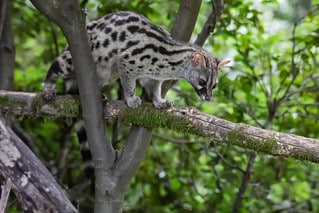The Genet cats in Uganda is cat-like carnivores belonging to the Viverridae family, are found in Uganda, with species like the Vaseline, large-spotted, and small-spotted genets being relatively common. They are often spotted during night drives, and can be found in areas like the Semuliki Wildlife Reserve, Murchison falls, Queen Elizabeth and Lake Mburo national parks; Genets are agile climbers and also spend time on the ground hunting for prey and seeking shelter.
They are nocturnal and only rarely appear during the day, though they are sometimes reported as foraging at twilight. They are Stealth hunters, much like the cats do and kill with a quick bite to the neck. Their sharp claws both allow them to pin prey and to be excellent climbers.
They are considered arboreal and climb trees to hunt birds; however, they also spend much time on the ground hunting prey and taking shelter in escarpments and rocky outcrops. They can squeeze their flexible bodies through any opening larger than their heads. They are also nocturnal and stealthy hunters.
Young kits are cuddly and affectionate, as is natural for most mammal babies. However, as they mature, adult genets revert to the solitary state and become aggressive, particularly around their food.
They live on the ground, but also spend much of their time in trees. They are considered solitary except during mating period and when the females have the offspring.
To intimidate aggressor genets will raise the crest of hair along their back to appear larger than they actually are. Genets are agile climbers and will often escape danger by heading to the trees where they can leap 3 to 3 meters tree to tree.
Genets are primarily nocturnal creatures, preferring to rest in burrows or holes in trees during the day and emerging at night to forage for food. Equipped with excellent night vision and acute hearing, they navigate their surroundings with remarkable agility and stealth.
Genets not only attack poultry; they are also extremely efficient rodent killers. Small rodents, reptiles, amphibians, and insects are all prey to the Genet in the wild. In captivity, a mixture of grain-free ferret and cat food is usually offered as a base diet with fruit, insects offered as daily additives.
Its behavior is essentially nocturnal and it hunts in the dark, returning afterwards to the safety and comfort of its burrow, which it lines with the vegetation it finds nearby.
Its five-toed paws have short, sharp, semi-retractable claws, which it uses to climb trees. Their tails are long and fluffy and are covered with eight to ten rings of black or grey fur. Their short limbs and wide, triangular ears further emphasize their resemblance to cats. Like them, genets are also agile, which is partly due to their light body weight –they weigh between 1.2 and 2 kilograms– and their long, slender bodies. In addition to jumping and climbing trees, they are also strong swimmers.
Their behavior for the common Genet is solitary. Adults are nocturnal and crepuscular with their highest levels of activity following sunset and just prior to sunrise, and the juveniles may be active during the day. They rest during the day in hollow trees or among thickets, and frequently use the same resting sites.
The small-spotted genets have highly flexible bodies, allowing them to squeeze though any narrow opening larger than its head. Similar to civets, they produce scent secretions for communication and, when threatened, can release a foul-smelling substance to deter predators.
Predators that hunt Genet in Africa include owls, snakes, leopards, fox and dogs. They prefer to live in habitats with dense vegetation such as bushes, thickets and forests. Because of their solitary nature, genets will seek out their own territory, and defend it from other males.
The Genet reaches sexual maturity at the age of two. It breeds all year round, but more births are recorded between April and May and between August and September. Gestation is short, only lasting about 70 days, and it is relatively common for them to have two litters a year. In each litter, one to four offspring are born. At eight weeks, after weaning, the youngsters are ready to leave the nest for the first time, but only at 12 months do they leave it for good.
The lifespan of genets is 8 to 12 years in the wild, but they can live up to 15 years and more in human care. Diet: Mostly meat, but they are opportunistic omnivores and will also eat eggs and fruit. Habitat: In areas with dense vegetation and forests.
Book your trip with Mirama Hills Safaris; check on our packages of which including night game drive to increase the chance of spot these nocturnal animals in wild.








